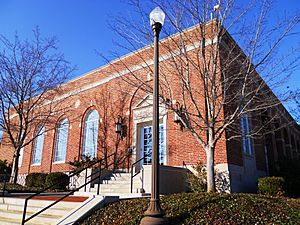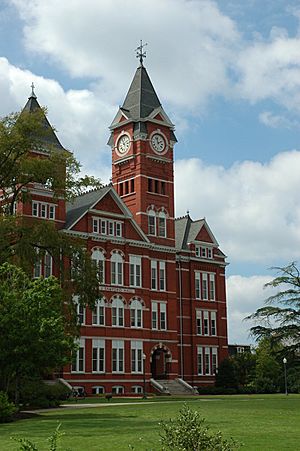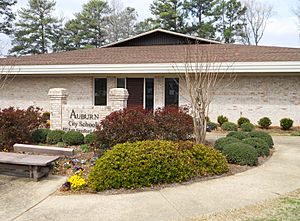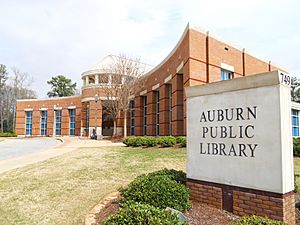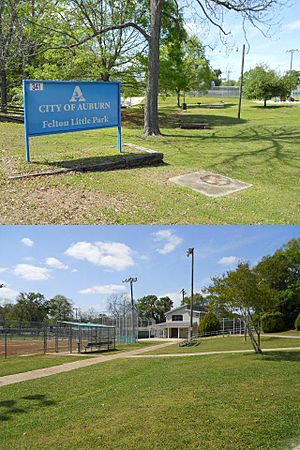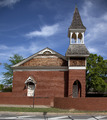Auburn, Alabama facts for kids
Quick facts for kids
Auburn, Alabama
|
|||
|---|---|---|---|
| City of Auburn | |||
|
Campus of Auburn University, downtown Auburn, one of Auburn's many biking and walking trails, and Auburn City Hall.
|
|||
|
|||
| Motto(s):
"The Loveliest Village On The Plains"
|
|||
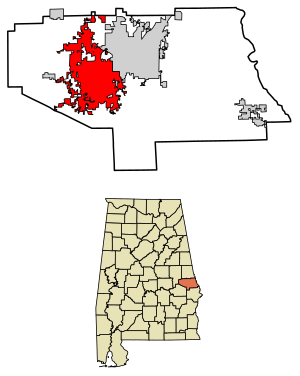
Location of Auburn in Lee County, Alabama.
|
|||
| Country | United States | ||
| State | Alabama | ||
| County | Lee | ||
| Founded | 1836 | ||
| Incorporated | February 2, 1839 | ||
| Area | |||
| • City | 62.07 sq mi (160.77 km2) | ||
| • Land | 61.04 sq mi (158.09 km2) | ||
| • Water | 1.03 sq mi (2.67 km2) | ||
| Elevation | 702 ft (214 m) | ||
| Highest elevation | 846 ft (258 m) | ||
| Lowest elevation | 387 ft (118 m) | ||
| Population
(2020)
|
|||
| • City | 76,143 | ||
| • Estimate
(2022)
|
80,006 | ||
| • Rank | US: 449th AL: 7th |
||
| • Density | 1,247.41/sq mi (481.63/km2) | ||
| • Urban | 100,842 (US: 310th) | ||
| • Metro | 199,289 (US: 231st) | ||
| Time zone | UTC-6 (Central (CST)) | ||
| • Summer (DST) | UTC-5 (CDT) | ||
| ZIP codes |
36830–36832, 36849
|
||
| Area code(s) | 334 | ||
| FIPS code | 01-03076 | ||
| GNIS feature ID | 0113277 | ||

Auburn is a city in Lee County, Alabama, in the United States. It is the biggest city in eastern Alabama. In 2020, about 76,143 people lived there. Auburn is a main city in the Auburn-Opelika Metropolitan Area. This area, along with nearby cities, is home to over 560,000 people.
Auburn is known as a historic college town. It is home to Auburn University. The city is one of the fastest-growing areas in Alabama. It has even been called one of the best places to live in the U.S. Its special nickname is "The Loveliest Village on the Plains." This name comes from a poem by Oliver Goldsmith.
Contents
History of Auburn
Early Days and Education
Long ago, the Creek people lived on the land where Auburn is now. In 1832, the land became open for new settlers. The first settlers arrived in the winter of 1836 from Harris County, Georgia. These pioneers, led by Judge John J. Harper, wanted to create a town. Their goal was to make it a center for religion and education.
Auburn officially became a town on February 2, 1839. It was part of Macon County back then. Early on, Methodist and Baptist churches were built. A school also opened its doors. By the mid-1840s, separate schools for boys and girls were added. Because of all these schools, many families moved to Auburn. By 1858, about half of the town's 1,000 free residents were students.
In 1856, the state approved a Methodist college. It was called the East Alabama Male College. This college, now known as Auburn University, started in 1859. It offered a classic and broad education.
Civil War and Recovery
When the Civil War began in 1861, Auburn became very quiet. All the schools closed, and most businesses shut down. Auburn had a hospital for soldiers during the war. The city only saw small battles in 1864 and 1865.
After the war, Auburn's economy struggled for many years. Public schools did not reopen until the mid-1870s. Many businesses stayed closed. Fires in the 1860s and 1870s damaged the downtown area. In 1872, the East Alabama Male College became a state college. It was renamed Alabama Agricultural and Mechanical College. It focused on agriculture and mechanics.
In 1892, the college made history. It became the first four-year college in Alabama to allow women to attend. This, along with new interest in farming science and engineering, helped the city grow again. By 1910, Auburn's population was back to what it was before the war. The college's football team also won championships. This brought more attention and money to Auburn.
Modern Growth
The early 1900s brought tough times. Cotton prices dropped, and then came the Great Depression. The state could not fund the college well. Since Auburn's economy depended on the college, people had to trade goods to survive.
Things got better when America entered World War II. Auburn's college campus became a training center for soldiers. After the war, many soldiers came back to school using the G.I. Bill. This led to a big growth period for Auburn in the 1950s and 1960s. Many new homes and businesses were built. The city grew to almost 24 square miles.
The building of Interstate 85 in 1957 connected Auburn to bigger cities. This meant Auburn University (renamed in 1960) could host more home football games. This helped tourism grow in Auburn. The Auburn Mall opened in 1973.
Growth slowed in the 1970s. People realized that relying only on the university was risky. In 1980, Jan Dempsey became mayor. The city changed its government system. The new leaders worked hard to bring in more industries. This led to a huge increase in industrial jobs.
Auburn's public schools also became very well-known. They were ranked among the best in the state and nation. This made many new families want to move to Auburn. Between 1980 and 2003, Auburn's population grew by 65%. Its economy grew by 220%. This fast growth has continued into the 21st century. The city keeps expanding and adding new areas.
Geography and Climate
Location and Landscape
Auburn is in western Lee County, Alabama. It shares a border with Opelika to the northeast. To the north, it touches Chambers County. The city also reaches south to the Macon County line.
Auburn sits on the Fall Line. This is where the piedmont plateau meets the coastal plain. Part of Auburn also has rocks from the Appalachian orogeny. This means the last foothill of the Appalachian Mountains is in Chewacla State Park. Because of these different areas, Auburn has a very varied landscape.
The western parts of the city have rolling plains and open grasslands. These areas are often used for cattle farming. South of this, the coastal plain has sandy soil and pine forests. Northern Auburn has rougher land with thick forests and deep valleys. The area around Chewacla Park has sharp peaks and sudden drops. This is where ancient Appalachian rocks meet the coastal plain.
Auburn is near the dividing line between two river systems. Most of the city is in the Tallapoosa River watershed. Three main creek systems drain Auburn. These are the Chewacla/Opintlocco Creek, Saugahatchee Creek, and Sandy Creek. The city hall in Auburn is about 709 feet above sea level. However, the elevation changes a lot across the city. It ranges from 386 feet to 845 feet above sea level.
Weather in Auburn
Auburn has a humid subtropical climate. This means it has mild winters and long, hot, humid summers. Spring comes early, and autumn is warm. The city gets a lot of rain, about 52.6 inches each year. But there is a drier time in late summer and early fall.
Severe thunderstorms are common from late winter to early summer. There is also a risk of tornadoes. Because Auburn is close to the Gulf of Mexico, it can be affected by tropical storms and hurricanes. Hurricanes Opal in 1995 and Ivan in 2004 brought heavy rains and strong winds.
Winters are usually mild. Snowfall is rare, with most years having no measurable snow. Most winter days have highs above 50°F. It rarely stays below freezing all day. Summers are long, hot, and humid. Highs often reach 90°F. The highest temperature ever recorded in Auburn was 103°F. The lowest was -7°F.
| Climate data for Auburn, Alabama (Auburn University) | |||||||||||||
|---|---|---|---|---|---|---|---|---|---|---|---|---|---|
| Month | Jan | Feb | Mar | Apr | May | Jun | Jul | Aug | Sep | Oct | Nov | Dec | Year |
| Mean daily maximum °F (°C) | 56.1 (13.4) |
60.4 (15.8) |
67.9 (19.9) |
74.6 (23.7) |
82.6 (28.1) |
88.3 (31.3) |
90.8 (32.7) |
89.8 (32.1) |
85.7 (29.8) |
76.8 (24.9) |
67.8 (19.9) |
58.2 (14.6) |
75.0 (23.9) |
| Mean daily minimum °F (°C) | 33.8 (1.0) |
37.3 (2.9) |
44.2 (6.8) |
51.3 (10.7) |
60.2 (15.7) |
67.0 (19.4) |
70.3 (21.3) |
70.5 (21.4) |
64.6 (18.1) |
54.8 (12.7) |
45.0 (7.2) |
36.3 (2.4) |
53.0 (11.7) |
| Average precipitation inches (mm) | 4.54 (115) |
4.36 (111) |
5.85 (149) |
3.84 (98) |
3.25 (83) |
4.61 (117) |
6.09 (155) |
3.22 (82) |
4.44 (113) |
3.19 (81) |
4.28 (109) |
4.88 (124) |
52.55 (1,337) |
| Average precipitation days (≥ 0.01 in) | 10.8 | 9.7 | 9.5 | 8.6 | 8.3 | 10.1 | 12.8 | 10.2 | 8.0 | 6.8 | 8.5 | 9.7 | 113.0 |
| Source: NOAA | |||||||||||||
People of Auburn
| Historical population | |||
|---|---|---|---|
| Census | Pop. | %± | |
| 1870 | 1,018 | — | |
| 1880 | 1,161 | 14.0% | |
| 1890 | 1,440 | 24.0% | |
| 1900 | 1,447 | 0.5% | |
| 1910 | 1,408 | −2.7% | |
| 1920 | 2,143 | 52.2% | |
| 1930 | 2,800 | 30.7% | |
| 1940 | 4,652 | 66.1% | |
| 1950 | 12,939 | 178.1% | |
| 1960 | 16,261 | 25.7% | |
| 1970 | 22,767 | 40.0% | |
| 1980 | 28,471 | 25.1% | |
| 1990 | 33,830 | 18.8% | |
| 2000 | 42,987 | 27.1% | |
| 2010 | 53,380 | 24.2% | |
| 2020 | 76,143 | 42.6% | |
| 2022 (est.) | 80,006 | 49.9% | |
| U.S. Decennial Census 2020 Census |
|||
Auburn first appeared in the U.S. Census in 1870.
Population in 2020
| Race | Number | Percent |
|---|---|---|
| White (not Hispanic) | 48,132 | 63.21% |
| Black or African American (not Hispanic) | 13,924 | 18.29% |
| Native American | 128 | 0.17% |
| Asian | 7,397 | 9.71% |
| Pacific Islander | 31 | 0.04% |
| Other/Mixed | 2,912 | 3.82% |
| Hispanic or Latino | 3,619 | 4.75% |
In 2020, there were 76,143 people living in Auburn. There were 26,156 households and 13,269 families.
Population in 2010
In 2010, Auburn had 53,380 people. There were 22,111 households and 9,939 families. The population density was about 919 people per square mile.
The city's population was 75.1% White, 16.5% Black, and 5.3% Asian. About 2.9% of the people were Hispanic or Latino.
About 17.5% of the population was under 18 years old. A large part, 38.0%, was between 18 and 24 years old. This is because of the many students at Auburn University. The average age in the city was 23.3 years.
The average income for a household was $35,857. For families, it was $72,771. Many students live in Auburn, which can make the household income seem lower. This is because students often have less income.
Auburn's Economy
Auburn's economy mainly revolves around Auburn University. The university employs about 4,300 people. This is about a quarter of all jobs in the city. Also, many people work for the government in jobs connected to the university. About 8,500 people work in service jobs.
Auburn also has a growing industrial side. This includes mid-sized, high tech companies that make things. Auburn has one industrial park and four technology parks. These parks focus on making small engines, car wheels, fuel cells, and vehicle armor. The Auburn Research Park opened in 2008. It has research in areas like high-resolution microscopy. The park also has an MRI Research Center. Overall, manufacturing provides about 5,000 jobs in Auburn.
Auburn is located between two large car manufacturing plants. The Kia Motors plant is about 35 miles east. The Hyundai Motors plant is about 55 miles west.
Education in Auburn
Education is very important in Auburn. The city is a college town because of Auburn University. The university had over 31,500 students in 2021–2022. Auburn University is known for its strong programs in business, engineering, agriculture, and veterinary medicine. It is a research university. Its main research areas include wireless engineering and transportation.
Auburn also has several research centers. One of these is the Ludwig von Mises Institute.
Auburn's public school system is highly rated. It has eight elementary schools, two middle schools, one junior high school, and one high school. The school system has been ranked among the best in the state and nation. Parenting magazine ranked it among the top 100 school districts in the U.S. The Wall Street Journal called it the best educational value in the Southeast.
Auburn's Early Education Center helps students with autism. It has won awards as a national Blue Ribbon school. Wrights Mill Road Elementary School also won a national Blue Ribbon award in 2009. Auburn Junior High School is known for its laptop program. This program gives laptops to students in 8th and 9th grade. Auburn High School has strong International Baccalaureate and Advanced Placement programs. Newsweek ranked it as a top public high school in Alabama in 2006.
The city has one main high school. It is a large, modern building that opened in 2017. It serves students in 10th through 12th grade. The old high school became a Junior High School for 8th and 9th graders. The old Junior High became East Samford School for 7th graders. Drake Middle School is for all 6th graders. Elementary schools are paired, with one school for kindergarten to 2nd grade and another for 3rd to 5th grade. The city plans to open a second high school in the future.
Auburn also has the Auburn Public Library.
Transportation
Auburn is in southeastern Alabama. You can reach it by Interstate 85, US 29, and US 280. The city has a small airport called the Auburn University Regional Airport. It is about 2 miles east of downtown.
The closest major airports are Hartsfield–Jackson Atlanta International Airport in Atlanta and Birmingham–Shuttlesworth International Airport in Birmingham. Both are within a 2-hour drive. They offer flights to many major airports around the world. There are also smaller regional airports nearby in Montgomery and Columbus.
You can find daily transportation between Auburn and the Atlanta airport. Local taxi services like Tiger Taxi and Eagle Town Taxi are available. Auburn University has a bus system called Tiger Transit. It runs near campus and to apartment complexes. Lee-Russell Public Transit offers a Dial-A-Ride service.
Auburn does not have many sidewalks or a city bus system. People mostly use cars to get around. However, Auburn has been recognized as a bike-friendly town. The Auburn Bike Committee shares information about bike rides and events.
Arts, Culture, and Recreation
Auburn is home to the Jule Collins Smith Museum of Fine Art. This museum has a collection of American and European art from the 1800s and 1900s. Its exhibits include works by famous artists like Jacob Lawrence, Ben Shahn, and Georgia O'Keeffe. You can also see engravings by naturalist John James Audubon. The museum also displays art by Dalí, Chagall, Renoir, Picasso, and Matisse. There are also sculptures, including Tibetan bronzes and a glass chandelier by Dale Chihuly.
The Telfair Peet Theatre in Auburn puts on plays and musicals every year. The Auburn Community Orchestra and the Auburn University bands perform many concerts. Some outdoor concerts are held at Kiesel Park in the fall. Other music groups include the Auburn Knights Orchestra, a big band jazz group. The Sundilla Acoustic Concert Series also offers musical performances. The theatre is said to be haunted by a ghost named Sydney. The theater department offers orange and blue M&M's to the ghost before each show.
Auburn also has the Auburn Area Community Theater (AACT). This group puts on three shows a year, including a children's show in the spring. All performances happen at the Jan Dempsey Community Arts Center.
There are many dance schools in Auburn. They offer classes in styles like ballet, jazz, hip-hop, and Irish dancing. The Drake School of Irish Dance supports Irish dancing in the city.
For fun and outdoor activities, Auburn has 16 parks. Chewacla State Park is a large park in the Appalachian foothills. Kiesel Park is a "passive" park with many trails. The Louise Kreher Forest Ecology Preserve is another great spot. The Donald E. Davis Arboretum has 150 different tree species native to Alabama. Auburn also has miles of multi-use trails and several lakes for outdoor enjoyment.
Sports
Auburn does not have professional sports teams. However, it has a lively sports culture because of Auburn University's NCAA Division I athletic teams. Auburn University football is a huge part of Auburn's culture and economy. When the university has home football games, over 100,000 visitors often come to the city. This brings in nearly $100 million each year. The university also has 17 other varsity sports. These offer many chances to watch high-level competitions.
Home football games change Auburn for several weekends a year. Thousands of fans arrive hours or even days before the game. They come to tailgate, creating a fun, festival-like atmosphere. Football games are played at Jordan-Hare Stadium. This stadium has 87,451 seats and is on the main campus, close to downtown.
Basketball games are held at the 9,600-seat Neville Arena. Baseball games are played at Plainsman Park. This park was named the best college ballpark in the nation in 2003. Auburn's swimming program is very strong. It has won many national championships. More Olympic swimmers have come from Auburn's program than any other university.
The Auburn Metro Area has 146 holes of golf across six courses. It has hosted several professional and amateur golf tournaments. Auburn Links was ranked as one of the top new courses in the nation in 1996. The Robert Trent Jones-designed Grand National course is also considered one of the best public courses. Because of this, Golf Digest ranked the Auburn Metro Area as the number 1 place for golf in the U.S. in 2005.
Media
Auburn gets its TV signals from the Columbus, Georgia Television Designated Market Area. Some stations from Montgomery, Alabama are also available on cable. Charter Communications and W.O.W. (Wide Open West) provide cable TV. DirecTV and Dish Network offer satellite TV. Eagle Eye TV is the on-campus TV station. It broadcasts 24 hours a day for students and nearby areas.
Radio stations WEGL and WAUD are based in Auburn. Radio station WKKR is licensed to Auburn but broadcasts from nearby Opelika.
Newspapers serving the city include The Opelika-Auburn News, The Auburn Villager, and The Auburn Plainsman.
Notable People
Auburn has been home to many famous people over its 170-year history. These include Nobel Prize winners like Frederick C. Robbins and George F. Smoot. World-class architects such as Paul Rudolph and Samuel "Sambo" Mockbee also lived here. The city has also produced artists, governors, generals, admirals, and professional athletes. Robert Gibbs, who was the White House Press Secretary for President Barack Obama, graduated from Auburn High School.
Images for kids
Nearby Cities and Communities
- Opelika, Alabama
- Loachapoka, Alabama
- Waverly, Alabama
- Beauregard, Alabama
- Beulah, Alabama
- Gold Hill, Alabama
- Bee Hive, Alabama
- The Bottle, Alabama
- Notasulga, Alabama
- Tuskegee, Alabama
See Also
 In Spanish: Auburn (Alabama) para niños
In Spanish: Auburn (Alabama) para niños





